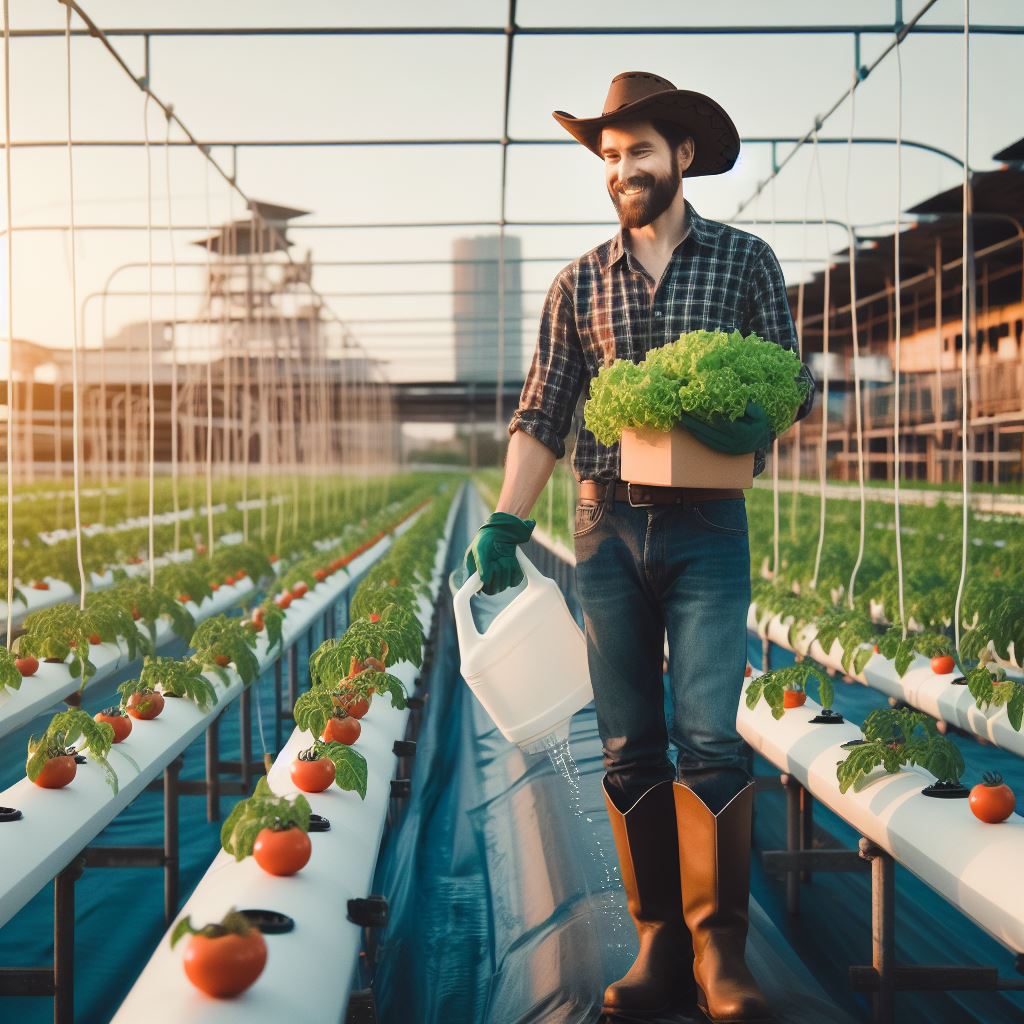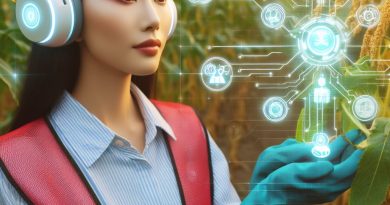Hydroponic Systems: Tech Advances
Last Updated on January 18, 2024
Introduction
A. Brief overview of hydroponic systems
Hydroponics is the method of growing plants without soil, using mineral nutrient solutions in water.
Plants are grown in inert mediums like gravel, perlite or coconut coir while their roots are submerged in the nutrient-rich solution.
Hydroponics allows growers to precisely control nutrients, light, temperature, humidity and other factors.
With hydroponics, plants can be grown faster, using less water and fewer pesticides than traditional soil agriculture.
B. Importance of tech advances in hydroponic systems
Recent technological advances are making hydroponic systems even more efficient and productive.
Sophisticated hydroponic setups now leverage automation, data analytics and artificial intelligence to optimize yields.
Sensors monitor pH, nutrient levels and other parameters, making automatic adjustments to create ideal growing conditions.
Software platforms integrate sensor data to control lighting, temperature, irrigation and more.
Machine vision systems can detect plant stress and diseases, triggering targeted nutrient or lighting changes.
Robotics and automation reduce labor needs for planting, moving and harvesting plants.
With hydroponic farms now scaling up into commercial-scale vertical farms, these kinds of smart systems are critical for managing large, intensive facilities.
C. Purpose of blog post
In this blog, we will explore the latest technology innovations powering the new generation of hydroponic systems.
From machine learning algorithms to robotic harvesters, these advances are helping hydroponic farms become more productive, efficient and sustainable.
The future of food may very well grow in high-tech urban vertical farms leveraging soilless agritech.
The Evolution of Hydroponic Systems
A. Traditional Hydroponic Systems
- Traditional hydroponic systems rely on nutrient-rich water solutions, providing plants essential elements for growth.
- Limitations include nutrient imbalances, manual monitoring, and the need for precise environmental control, hindering efficiency.
B. Early Tech Advancements
- Artificial lighting revolutionized hydroponics, enabling year-round cultivation independent of natural sunlight.
- Automation took root with timers and pumps, streamlining tasks, enhancing precision, and reducing the burden on growers.
In the realm of hydroponic agriculture, the evolution from traditional methods to technologically advanced systems has been nothing short of revolutionary.
Traditional hydroponic systems, the bedrock of this agricultural approach, operate on the principle of delivering essential nutrients directly to plants through a water-based solution.
However, they come with their set of limitations. Maintaining nutrient balance, manual oversight, and the necessity for precise environmental control pose challenges, impacting overall efficiency.
The tide turned with early technological advancements. The introduction of artificial lighting marked a turning point, liberating hydroponic farming from the constraints of natural sunlight.
This innovation enabled growers to cultivate crops year-round, regardless of external weather conditions.
Moreover, automation stepped into the spotlight with the integration of timers and pumps.
These technological marvels brought unparalleled efficiency to hydroponic systems.
Tasks that once demanded constant human attention were now handled seamlessly by automated processes, reducing the workload on growers and enhancing the precision of cultivation.
In this dynamic journey from tradition to technology, hydroponic systems have not only overcome challenges but have also set the stage for a new era in sustainable and efficient agriculture.
Read: Automated Farming: Pros & Cons Explored
Recent Technological Advances in Hydroponic Systems
In recent years, hydroponic systems have witnessed significant technological advancements that have revolutionized the way plants are grown in controlled environments.
This section explores some of the recent breakthroughs in hydroponic systems that have paved the way for enhanced plant growth and increased yields.
A. Improved lighting solutions
One of the key advancements in hydroponic systems has been the development and utilization of LED lights.
LED lights offer several benefits over traditional lighting sources such as fluorescent or high-intensity discharge (HID) lamps.
LED lights are highly energy-efficient, consuming less electricity while generating optimal light output for plant growth.
Moreover, their longer lifespan reduces the need for frequent replacement, resulting in cost savings for hydroponic growers.
LED lights also provide the advantage of spectrum control, allowing growers to customize the light spectrum according to the specific needs of different plants.
By adjusting the wavelengths emitted by the LED lights, growers can optimize plant growth at various stages, enhancing photosynthesis, flowering, and fruiting.
This level of control enables hydroponic systems to maximize plant productivity and quality.
B. Sensor-based monitoring and control
Another significant technological advancement in hydroponic systems is the integration of sensor-based monitoring and control mechanisms.
Sensors play a crucial role in measuring essential parameters such as pH, temperature, and humidity levels within the growing environment.
With real-time data captured by sensors, growers can closely monitor these factors and make necessary adjustments to maintain optimal growing conditions.
Furthermore, automated nutrient supply systems can be implemented based on sensor data to ensure precise and timely delivery of nutrients to the plants.
By continuously monitoring the nutrient levels in the hydroponic solution, the system can adjust the nutrient supply automatically, providing plants with the optimal balance of essential elements for healthy growth.
This automation reduces the manual labor required for nutrient management and minimizes the risk of nutrient deficiencies or toxicities.
C. Smart irrigation systems
Water management is a critical aspect of hydroponic systems, and recent technological advances have significantly improved irrigation efficiency.
Smart irrigation systems utilize advanced technologies to deliver water precisely to the plants, minimizing wastage and maximizing water utilization.
These systems employ techniques such as drip irrigation, aeroponics, or fogponics to provide plants with the right amount of water directly to their roots.
In addition to water conservation, smart irrigation systems also help optimize nutrient absorption.
By ensuring the ideal moisture levels in the growing medium, these systems facilitate proper nutrient uptake by the plants, promoting healthy growth and minimizing nutrient leaching.
Essentially, recent technological advancements in hydroponic systems have brought about a paradigm shift in the way plants are grown.
Improved lighting solutions, sensor-based monitoring and control, and smart irrigation systems have revolutionized the efficiency, productivity, and sustainability of hydroponics.
As these technologies continue to evolve, we can expect even more exciting possibilities for the future of hydroponic cultivation.
Read: Climate Smart Agri: Tools & Techniques
The Impact of Tech Advances on Hydroponic Farming
A. Increased crop yields and quality
Hydroponic systems have witnessed significant advancements in technology, resulting in numerous benefits for farmers and the overall agricultural industry.
These technological improvements have revolutionized the way crops are grown, leading to increased crop yields and higher quality produce.
With the help of advanced tech, hydroponic farmers now have enhanced control over growing conditions.
They can fine-tune factors such as temperature, lighting, and nutrient levels, creating an optimal environment for plant growth.
This level of control is not achievable in traditional farming methods, where crops are subjected to fluctuating outdoor conditions.
Tech advances have also improved nutrient delivery and absorption in hydroponic systems.
Farmers can precisely monitor and adjust the nutrient levels in the water solution, ensuring that plants receive the ideal balance of essential elements for growth.
This precision leads to healthier plants with better nutrient uptake and ultimately results in higher-quality crops.
B. Efficiency and sustainability
Another significant impact of tech advances on hydroponic farming is the increased efficiency and sustainability of the cultivation process.
Tech innovations have enabled hydroponic systems to reduce resource consumption compared to traditional farming methods.
Hydroponic setups require less water than conventional soil-based farming, as water is recirculated and reused.
Additionally, nutrients are delivered directly to the roots, reducing the need for excessive fertilizers.
These efficiency gains result in significant resource savings, making hydroponics a more sustainable approach to agriculture.
Hydroponic systems have a lower environmental impact compared to traditional farming.
By reducing water usage and minimizing the runoff of fertilizers and pesticides, hydroponic farming helps prevent pollution of water bodies.
The controlled indoor environment also mitigates the need for chemical pest control, further reducing the overall use of harmful substances.
This environmentally friendly approach aligns with the growing demand for sustainable farming practices.
C. Cost-effectiveness and scalability
Lastly, the advancements in hydroponic technology have made the cultivation method more cost-effective and scalable.
Hydroponic systems offer lower operational costs compared to traditional farming.
While initial setup costs may be higher due to technology investment, the ongoing expenses are significantly reduced.
Water and nutrient savings, as well as the elimination of the need for large tracts of land, contribute to overall cost savings.
Additionally, hydroponic systems often require fewer labor hours, further reducing operational expenses.
Hydroponics has become easier to scale up with the help of technological advancements.
Farmers can expand their operations by adding more grow units or vertical farming systems without requiring extensive land resources.
The controlled indoor environment allows for higher crop density and more efficient space utilization.
This scalability makes hydroponics an attractive option for commercial growers seeking to increase their production capacity.
In essence, tech advances have revolutionized hydroponic farming, bringing benefits in terms of increased crop yields, improved quality, enhanced efficiency, sustainability, cost-effectiveness, and scalability.
These advancements will continue to shape the future of agriculture, providing solutions to feed the growing global population while minimizing the environmental impact.
Read: Hydroponics 101: Basics & Benefits

Future Trends and Possibilities in Hydroponic Systems
In recent years, advancements in technology have revolutionized hydroponic systems, leading to increased efficiency and productivity.
However, the potential for further development and innovation in this field is immense.
In this section, we will explore some of the future trends and possibilities that can shape the future of hydroponics.
A. Integration of Artificial Intelligence and Machine Learning
Artificial intelligence (AI) and machine learning (ML) have already transformed various industries, and hydroponics is no exception.
By integrating AI and ML algorithms into hydroponic systems, growers can achieve unprecedented levels of precision and optimization.
AI-powered systems can analyze vast amounts of data collected from sensors placed within the hydroponic setup, including temperature, humidity, pH levels, and nutrient levels.
Based on this data, the AI algorithms can make real-time adjustments to maintain optimal growing conditions.
Furthermore, machine learning models can learn and adapt over time, continuously improving the efficiency of hydroponic systems.
These technologies can also detect patterns, predict plant growth rates, and suggest customized nutrient profiles for specific crops.
B. Development of Vertical Farming Systems
Vertical farming, which involves growing plants in vertically stacked layers, is gaining popularity as a sustainable agriculture solution in urban areas with limited space.
As technology advances, vertical farming systems will become more efficient and viable.
Hydroponic vertical farming systems are already being used in some urban areas to grow a variety of crops such as leafy greens, herbs, and even fruits.
These systems utilize vertical growth towers equipped with hydroponic setups, LED lights, and automated irrigation systems.
The future will see further advancements in vertical farming technology, including the use of advanced lighting systems, robotics, and improved irrigation techniques.
These developments will enable vertical farms to produce higher crop yields while conserving resources like water and land.
C. Expansion of Urban Farming Initiatives
The rise of urban farming initiatives will continue to shape the future of hydroponic systems.
With increasing concerns about food security, sustainability, and the environmental impact of traditional agriculture, more cities around the world are embracing urban farming.
Hydroponic systems are at the forefront of urban farming initiatives due to their ability to maximize yields in limited spaces.
As technology and infrastructure improve, urban farms will become more prevalent, providing fresh produce to local communities.
These initiatives will also promote community engagement and education about sustainable farming practices.
Urban farming parks and rooftop gardens will become common sights, fostering a sense of connection between urban dwellers and the food they consume.
In a nutshell, the future of hydroponic systems holds immense potential for further advancements.
The integration of artificial intelligence and machine learning will revolutionize precision agriculture.
Vertical farming systems will become more efficient and widespread, addressing the challenges of urban food production.
Urban farming initiatives will continue to grow, supporting sustainable agriculture practices and creating a healthier and more environmentally conscious society.
Read: Top 5 Trends in Vertical Farming Tech
Conclusion
The advancements in technology are revolutionizing hydroponic systems, making them more efficient and sustainable.
With the integration of advanced sensors, automation, and AI, hydroponic systems can now closely monitor and optimize plant growth.
These tech advances not only maximize yield but also reduce resource consumption, such as water and energy.
Furthermore, these innovations enable growers to control environmental factors, such as temperature, light, and nutrient distribution, with precision.
By embracing modern hydroponic techniques, farmers have the opportunity to increase productivity while minimizing the environmental impact.
Whether you are a hobbyist or a commercial grower, exploring these tech advancements can lead to significant improvements in your hydroponic operations.
From vertical farming to aeroponics, there are various modern techniques that can be easily adopted with the help of technology.
By staying informed about the latest advancements and experimenting with new systems, growers can stay ahead in the hydroponic industry.
The future of hydroponics lies in the integration of technology, and it’s important for everyone interested in this field to embrace and leverage these innovations.
So, start exploring and implementing modern hydroponic techniques today to unlock the full potential of this sustainable and efficient cultivation method.


